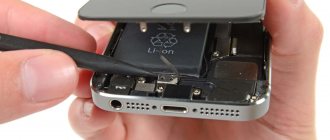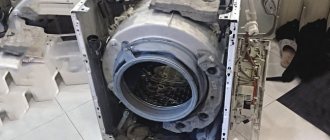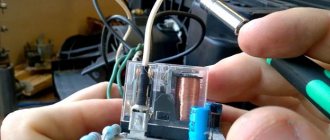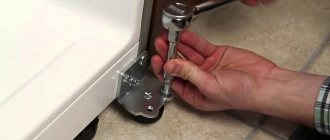It is worth repairing a multicooker if you are confident in your abilities.
Such a household appliance as a multicooker has become so firmly established in our lives that it is difficult to imagine a time when we did not know what it was. Despite its modest appearance, it can be used to cook, stew, steam, fry and heat food. The Redmond multicooker was no exception. But, unfortunately, all devices can periodically be subject to various breakdowns. Some of them can be repaired with your own hands.
The display does not light up
Photo 1 . Here the display lights up, the clock is running, because the battery has already been replaced
It turned out that the battery, which is located inside the device and even soldered to the power supply board, had run out. In order to change it, you need to disassemble the device, which is what we will do now, and at the same time we will dig into the guts for a diagram of the internal structure, components used, etc.
First of all, let's ask a sudden question: why didn't they make the battery externally replaceable? The answer is this: there’s a sticker on this multicooker that says the warranty is 25 months, but this is not so much a guarantee as a planned resource, i.e. after two years, according to the instructions, it needs to be thrown away, and the black screen will contribute to this.
But I paid 100 bucks for it! But this is in Russia, where everything is exorbitantly expensive. On Alibaba, such a multicooker costs up to 30 bucks (in quantities of 500 pieces; and the cost, judging by the minimum price, is $15). It’s simply amazing how cheap the Chinese are for such a complex device (with a microcontroller, a monitor, an electric stove, a saucepan, a bunch of plastic and metal), and how much the Russian hucksters put into their pockets for pressing the “buy” button on Alibaba, without inventing anything, without investing, without producing,...
In addition to the joke with the battery and the price, there are a couple of drawbacks: after the end of any program, the multicooker turns on endless heating (70 degrees). Because of this, it is inconvenient to cook yogurt in it: it simmers for 8 hours at a temperature of 40°C, and then, if you do not have time to turn it off, the yogurt begins to heat up to 70°C, while it needs to be cooled and put in the refrigerator. The clocks are also advancing by 10 minutes per month.
TOP 4 multicookers Redmond premium segment
REDMOND RMC-IHM302
Price – 10900 rub. Induction heating, power - 1250 W, which confidently makes the model indicative in the premium segment. The 4-liter bowl with non-stick Teflon coating makes cooking and caring for the appliance easy. The touch control makes it easy to launch and adjust programs. In terms of the number of automatic programs, of which there are 11, the model is inferior to the Redmond RMC-M140. In the latest version there are 33 of them.
Advantages:
- induction heating. The multicooker starts cooking immediately from the moment it is turned on;
- convenient control.
Flaws:
- some users have difficulty understanding the instructions;
- inconvenience when washing. According to subjective assessments, washing the lid at first is inconvenient.
Considering induction heating, this multicooker cooks faster. There are 11 auto programs here, but compared to SkyCooker CBD100S, the price remains at an affordable level.
Reviews on Yandex.Market
REDMOND SkyKitchen CB391S
Price – 11,500 rub. This is not just a multi-cooker, but a real multi-kitchen. You can place any heat-resistant cookware on the raised heating element or choose the appropriate one from the 50 multicooker programs. A power of 1000 W and a 5-liter bowl will help diversify any menu.
Advantages:
- remote control. By installing the application on your smartphone, you can enable the multi-kitchen to work remotely;
- advanced functionality. The model acts as an alternative to a stove with oven;
- removable inner cover. Makes cleaning easier;
- additional accessories. Baskets for deep-frying and steaming, frying pan, tongs.
Flaws:
- no lid for the frying pan;
- poor quality of bowl coating. Users complain that the coating deteriorates very quickly.
The SkyKitchen CB391S multi-kitchen, given its functionality and price, remains one of the manufacturer’s popular household appliances. Compared to the SkyCooker CBD100S, this purchase is very practical.
Reviews on Yandex.Market
REDMOND RMC-M140
Price – 13800 rub. The power of 1300 W helps to use the model even as a pressure cooker. Compared to the REDMOND SkyCooker CBD100S, there are significantly more automatic programs - 33 compared to 21. A 5-liter Teflon-coated bowl will help you prepare enough for a large family.
Advantages:
- high quality of material and workmanship;
- bowl with handles;
- simple controls. Even an inexperienced user can handle setting up and adjusting programs.
Flaws:
- if you do not carry out the preliminary preparation described in the instructions, you will notice an unpleasant odor;
- cord length (too short).
Given the good power and variety of automatic programs, this multicooker can confidently be considered a practical purchase. Its price compared to SkyCooker CBD100S is significantly lower.
Reviews on Yandex.Market
REDMOND SkyCooker CBD100S
Price – 16800 rub. Large bowl volume (9.5 l) compared to the 5 l REDMOND RMC-P350. The power is also high - 1600 W. 21 built-in automatic programs: you can prepare first courses, solve the problem of baking, making yogurt, jam and jellied meat.
Advantages:
- built-in radio. A nice bonus, but this addition does not affect the operation of the device in any way;
- remote control. Application installation required.
Flaws:
- high price. It is overpriced for everyday use;
- Difficult to understand the instructions. It will be difficult for an inexperienced buyer to understand the operation of a multicooker without outside help.
The multicooker is suitable for domestic or professional use. Its price is quite high, so the REDMOND SkyKitchen CB391S multi-kitchen model is a better purchase.
REDMOND multicookers, given their range and constant modernization of equipment, deservedly enjoy their popularity. We hope that the proposed review will help you choose the right model.
Reviews on Yandex.Market
Let's figure out what's inside CONTENTS
Let's start picking. Let's start with the fact that “few people know”, but the Redmond M70, M4502, M45011 multicookers are identical externally and internally, the parts are interchangeable. So everything below is true for any of them. So, we lay the patient down with his paws on top and unscrew 6 screws:
Photo 2. Paws up
We snap off the bottom, we have:
Photo 3. Multicooker Redmond M45011 inside
- There is a “button” at the bottom of the tank, inside of which there is a temperature sensor and a thermal fuse.
- Two blue wires going into the cover. There in the lid they feed the cord heating element.
- Main disk heating element with a power of 860 W.
- Two black wires going into the cover, where a temperature sensor is connected to them.
- Cord heating element around the tank.
- 2xAA batteries supplied here instead of the dead CR2450.
- The place where the CR2450 was soldered.
- Power supply board (PSU).
- Microcontroller and monitor board with control buttons.
E1
Error E1 for the Redmond multicooker - a break in the lower temperature sensor or overheating of the device. An error code appears on the display if there is a problem with the temperature sensor or if the central heating mechanism overheats. If the cause is eliminated in time, this failure rarely leads to serious damage.
Reasons E1
Error code E1 indicates a problem with the temperature control mechanism. Several factors can lead to this problem:
- food debris and solid grains getting between the bottom and the multicooker bowl;
- moisture entering the heating sensor;
- heating sensor overheating;
- random software glitch.
In this case, the temperature sensor can operate stably, but the display will display information about emergency mode.
Elimination E1
If an error code appears on the device display at the very beginning of operation, this may indicate a system failure. Simply reboot the device. To do this, you need to completely turn off the multicooker by unplugging the plug from the outlet. Then let the device cool down, leaving it for 10-15 minutes.
It is worth rebooting the device first of all if an E1 failure appears on the display of a completely new multicooker that has been running for one or two days.
If the error appears on a device that has been in use for a long time, the likelihood of a system problem is significantly reduced. Then you may need to disassemble the device:
- Turn off the device and let it cool down.
- Remove the bowl from the housing and make sure that there are no remaining moisture or foreign substances on its surface.
- Unfasten the bottom of the multicooker and find the thermocouple in the very center of the base.
- Press the top plate on the side of the adjusting screw until it clicks.
- Clean the terminals using fine-grit sandpaper.
- Reinstall the components and turn on the device again.
To prevent moisture and food particles from entering the interior, rinse the appliance thoroughly after each use, wiping the bowl and lid dry.
Replacing the BatteryCONTENTS
CR2450 button cell battery (diameter 24 mm, thickness 5 mm, lithium, 3 volts) in the location indicated by the arrow 7.
Photo 4. The required battery
First, it was soldered to the petals using one-sided spot welding, then the petals were soldered into the board, and in order to make its replacement as difficult as possible, the manufacturers filled this place with a heap of fairly strong glue. In order not to mess with the glue and not unscrew the power supply board, we pick off the contact petals from the dead battery with a knife (or cut it off with a chisel, or tear it off with pliers).
It was not possible to find such a large replacement battery... I’ve never seen anything like this on sale in my life! Therefore, idea No. 1: we use 2 AA-size batteries of 1.5 volts each. We hang on a hook (there is one for wires, position 6. ) a block of two batteries (we fasten them together with a clamp towards each other; on one side we solder wires to ➕ one and ➖ the other), which we solder with wires to those sticking out of the board petals, observing the polarity (there is a marking on the board ➕). If you don’t have a soldering iron, you can solve everything with tape (super life hack idea No. 2 ):
Ill. 1. Replacing the coin cell battery with 2 finger batteries using tape
- We fasten the batteries with tape across them.
- Using a winding tape, we press some metal plate or piece of solid wire longitudinally in the middle to connect the batteries in series.
- We press the exposed ends of the double wire with two more rolls of tape. The ends of the wires on the other side are exposed long. The plus wire is marked red.
- We wrap the ends of the wires around the petals on the board and crimp them with tape for insulation.
Measurements have shown that in order for the clock to stop ticking, the battery must discharge to 2.30 volts. When the voltage across it is 2.50 V, the screen actually does not light up, but the clock runs. The current consumption at a voltage of 3.2 V is 24 µA, therefore, when using a battery with a capacity of, say, 1 A/h, we have 40 thousand hours of operation - that’s 4.5 years.
Sudden idea No. 3: what if, to two AA batteries that have run down to 1.25 volts, we add another one of the same 1.25-volt battery that has run out in another device? Well, let's do this:
Photo 5.
Barathea from 3 AA cells of 1.25 volts
Photo 6.
How the display shines from three stuck elements
It turned out... and it’s great: the voltage on such a battery is 3.8 volts, the display glows very brightly (see Photo 6). It seems that such a battery will be discharged to 2.30 volts for about 2 years. And in general, this is an excellent topic on how to fuse batteries that are not yet dead in other devices (it’s a pity to throw them away - they’re expensive, a whole $1 of the United States per unit). are worth).
Expected idea No. 4: install an ionistor instead of a battery:
Photo 7.
Super capacitor 5.5 V x 4 F
Photo 7.
Eternal battery in action
Such an ionistor for 4 farads and 5.5 volts costs about $0.7 [lot on Aliexpress], that is, cheaper than one 1.5-volt battery from Ill. 1 and Photo 5/6. The Schottky diode next to the battery must be closed with a resistor (see Photo 7; why? - see Diagram 1 below).
Based on the theory/datasheets of the operation of ionistors, such an ionistor needs to be charged with a current of 100 μA for 24 hours to minimize its self-discharge and increase its service life, therefore [in Photo 7] a 36 kOhm resistor is installed. But with a discharge current of ~25 μA, we get a charge-discharge time ratio of 1:4, i.e., for 5 hours the multicooker runs from the mains and the ionistor is charged, then the ionistor powers the display and the clock for the remaining 24 hours. If the multicooker is used not for 5 hours every day, but, for example, for 4 hours a week, then we install a 3.6 kOhm resistor - this is worse for the health of the ionistor... well, to hell with it, it’s cheap. (In the end I set it to 1 kOhm.)
Now, just for fun, let’s study the remaining components of the multicooker.
Do-it-yourself multicooker repair
If the multicooker stops responding to any actions, does not heat, beeps, does not heat up well, does not turn off, blinks or displays errors on the display, it must be inspected and, if necessary, repaired. This can happen with any brand of equipment, and it doesn’t matter whether it’s Samsung, Redmond or Vitek.
The main thing is to remember that you need to work with electrical appliances very carefully, observing all safety measures and be sure to remove the plug from the socket! Just turning off the multicooker is not enough!
Before you start repairing a multicooker, you should study the recommendations of specialists and watch a training video
What to do if the multicooker:
- It turns off before the appointed time - the cooking mode may have been selected incorrectly or there has been too much food. To do this, you need to turn off the device, check the recipe and restart it again. The thermal protection may also trip, the valve may become clogged, the food in the bowl will burn, or there may not be enough liquid to continue the cooking process. Sometimes the problem may be a violation of the integrity of the bowl or a sensor failure.
- It takes too long to cook food - most likely, the temperature is set incorrectly, there is too much food, or the bowl is not positioned as it should be. It is worth restarting the device, letting it stand for a while and checking the installation of the bowl.
- It switches to heating on its own - you can fix the problem by holding the “O” button and in a few seconds everything will return to normal.
- Doesn’t count down time - probably a software error has crept into the device’s operation or the timer is not configured. You need to carefully read the instructions and, if necessary, manually set the timer.
- It beeps - in this case, the contacts of the device may short-circuit. Sometimes it is enough to remove the battery for the squeak to stop.
What is the button at the bottom? CONTENTS
1. The “button” at the bottom of the tank turned out to be not a switch button at all, as it seems (so that the multicooker would turn on only when a pan was installed inside the tank), but simply a block pressed tightly to the pan with a temperature sensor and a thermal fuse inside.
Photo 5. “Button” - a block with a temperature sensor and a thermal fuse
The red wire here is the network wire, from 220 volts, first it passes from the socket through the thermal fuse in this button (the official name is “thermal fuse 165°C 10A”; when burned, it cuts off the power from the network), then it is connected to one of the terminals of the disk heating element and only then goes into the power supply board. Yellow thin wires go to the temperature sensor (it is an NTC thermistor with a resistance of 50 KOhm at 25°C).
Thermal fuse
The above-mentioned device, for which they asked for 5,000 rubles to repair, suffered from a common disease. The self-taught master opened the multicooker body, poured out the porridge, got to the thermal fuse, and replaced it. Then, having assembled the device, he gave it to the owner.
What is a thermal fuse. When it comes to repairing a multicooker, we are talking about a cylindrical piece of wire that strongly resembles a resistor in appearance. The operating temperature is 170 ºС, the maximum current is 10 - 15 A, depending on the type of element. When these parameters fall outside the permissible range, the thermal fuse burns, breaking the electrical circuit in which it is connected.
Why can't you make this item yourself? Firstly, the cost of the element is modest, and secondly, they installed a thermal fuse for a reason. A homemade copy has different characteristics, which will not lead to good things. Repairing a multicooker at home using such amateur activities will, in the worst case, end in a fire.
Is there anything in the lid? CONTENTS
2. and 4. Wires going into the cover:
Photo 6. On the left are 2 black wires and 1 yellow, on the right are 2 blue
The yellow wire on the left is ground. The black wires on the left are the temperature sensor in the lid (there in the lid it is glued to the lower aluminum part of the lid using sticky aluminum foil):
Photo 7. Temperature sensor from the lid
(The wires are randomly blue here because this sensor is from the M70 model, and the previous photo is M45011).
This temperature sensor, exactly the same as in the “button” below, is an NTC thermistor (the resistance of which is lower, the higher its temperature) in a glass shell. The resistance of this resistor at 25°C is 50 kOhm.
The blue wires on the right (in Photo 6) power the cord heater (tubular electric heater in the form of a cord) in the lid, which was also glued to the lower aluminum part of the lid using adhesive aluminum foil.
Photo 8. Cord-heater from the lid
Resistance 2.8K (17 W, taking into account the fact that it is powered from 220 volts). Connects to 220V network via triac BT131.
Choosing detergents
During the cooking process, various food particles often get into the interior of an electrical appliance.
Some housewives, in a hurry to prepare lunch or dinner, violate the rules for the sequence of placing food in a multicooker: they place food in the bowl without first removing it. To clean the unit, it is unacceptable to use hard sponges and abrasive detergents, as they can easily damage the internal and external parts of the device.
The best option for removing contaminants from the surfaces of the device are mild chemicals and home remedies.
Household
- Care kit for Zumman multicookers - the German product kit includes a liquid cleaning agent, wet wipes with varying degrees of lint hardness on the front and back sides. With the help of napkins, you can quickly and effectively remove dirt from any surfaces of the device; in case of significant accumulation of plaque on the elements of the unit, use the product in the form of a liquid.
- Top House is a gel designed for the care of household appliances used for cooking and non-stick cookware. To remove grease stains from a multicooker, apply a small amount of gel to a sponge, foam it and treat the contaminated surfaces, then remove the remaining product with a damp cloth and rinse the device.
- Sanita spray “1 minute” is a domestic product that can effectively remove stubborn grease deposits and is suitable for cleaning various types of surfaces. After spraying the drug onto contaminated areas, wait 1-2 minutes and wipe the treated areas with a damp cloth, then rinse with water.
Folk
In some cases, the use of household chemicals is not suitable for caring for an electrical appliance: for example, a person experiences an allergic reaction upon contact with a certain product.
After using ready-made preparations for cleaning surfaces that will then come into contact with food, the treated containers must be washed several times in clean water. If the rinsing procedure is not carried out thoroughly, the remaining chemical particles can have a negative effect on the living organism.
Citric acid perfectly cleans the microwave from grease.
It should be said that most available products have no less cleaning effect than special preparations:
- pour 25 g of citric acid into 200 ml of warm water, stir the ingredients;
- pour the solution into the bowl of the electrical device and turn on the steam cooking mode for 15 minutes, then drain the liquid, rinse the tank and wipe it dry.
Lemon will help get rid of plaque and eliminate unpleasant odors: pour a glass of water into the bowl and place half a citrus fruit there. As with citric acid, turn on the device in steam mode for a quarter of an hour. After the time has passed, drain the liquid and wash the tank in running water and dry it.
Find out how to descale an electric kettle using citric acid. This article will tell you about cleaning your iron from limescale.
Loading …
Heating elementsCONTENTS
5. The cord-heater around the tank looks exactly the same as in the photo above. Also glued with foil. But its resistance is 1240 Ohms, respectively, the power is 40 W. Connects to the network via a triac BT134.
3. Main disk heating element with a hole in the center:
Photo 9. Lower main heating element
Power 860 W, resistance 54 Ohm, connected to the network via an electromagnetic relay. Therefore, while the multicooker is operating, “something” (namely the relay) clicks all the time.
Design and principle of operation
All blenders are divided into several categories, which differ from each other in design and method of use, as well as different attachments and functionality. To effectively and correctly carry out repairs, you should understand the design features.
Stationary
Stationary varieties look like small food processors and are bowls with knives rotating inside. As a rule, the knives are installed at the bottom of the bowl. The device is desktop and does not need to be held during operation. This blender model is capable of grinding a large portion of food at a time.
The main disadvantage of stationary devices is the need to allocate a lot of storage space. In addition, some models do not chop vegetables well and grind them into crumbs or leave too large pieces. In terms of repairs, stationary equipment is much easier to disassemble and repair compared to submersible equipment.
Manual (submersible)
Hand blenders are shaped like a long handle with a cutting end. The nozzle is lowered into the container with the products, the device is turned on and held until the grinding process is completed. Due to their compact size, submersible devices do not require much storage space in the kitchen. The ability to change attachments significantly expands the list of food preparations.
This creates discomfort during long-term cooking. Also, the device is not suitable for stirring large portions of food.
Power supply, its diagram CONTENTS
8. Power supply boards M70 and M45011:
Photo 10.
M70 power board
Photo 11.
M45011 power board
There are no parts on the back side of the M70 board, there is not a single chip part, but on the M45011 half of the parts are SMD-sized and soldered on the back side:
Photo 12. Multicooker M45011 power board from the back side
Despite the different layout of parts, these are identical boards that implement this circuit:
Diagram 1. Diagram of the power supply RD110402 of the REDMOND RMC-M70 multicooker
The voltage conversion is built on an eight-legged THX203H chip [datasheet] (PWM controller - PWM controller, switching power supply regulator). In the diagram ACN and ACL - 220 volt power supply. HEAT - to the main 860-watt heater terminal.
Here, in the comments under this article Oleg wrote on January 10, 2022 that on the declared 5-volt output of this power board for a working multicooker, it is not +5 V, as written on the board, but 3.6 volts. Testing on working multicookers M70 and M45011 showed that this is accurate: exactly +3.54 V for both. So the display and MK are safely powered at a normal voltage of 3.6 V.
The M45011 board has some differences from this diagram above (which is for the M70):
- other designations (instead of TR3 and TR4 - TR1 and TR2; instead of +5V - Vcc; the numbering of transistors Q6, Q7, etc. is shifted down)
- no fuse F1
- The PWM controller is called AP8012 [datasheet]
- instead of the BT134 triac there is a BT131
- key transistors with different markings: one large DF331, chip J3Y
- Varistor ZN2 is marked 10K300
Solution
The instruction manual advises the user to follow recommendations regarding troubleshooting. If the situation has not changed, then there is only one way out - a service center.
| Error code | What to do? |
| E1 | Check the bowl for holes and perforations Clean the multicooker from dirt by carefully turning it upside down after turning it off Check whether the heater works when the plug is plugged in without the bowl |
| E2 | Check whether there is a network in the appliance and whether the food selection functions work. Check operation with the lid open and closed. |
| E3 | Open and close the top cover tightly again Check the operation of the heating element |
| E4 | Contact a service center, as this error may appear if the central board is faulty |
| E5 | Turn off the multicooker for 3-4 hours, let it cool completely and turn it on again |
In some cases, the problem detection sensor shows an incorrect error code, which complicates the process of finding and solving it. If all of the above actions are not successful and do not restore the multicooker’s functionality, you cannot do without a service center.
It is not recommended to open the multicooker yourself, disconnect the boards and check them for malfunctions. If this fact is discovered at the service center, the customer will be denied warranty service. Lack of experience can only aggravate the problem and make further repairs impossible.
Controller board, MCU
9. Under the power supply board there is a controller (control) board:
Photo 13. Controller board
On one side of this board: display, buttons, tweeter (see Photo 12). On the other side:
Photo 14.
M70 controller board
Photo 15.
M45011 controller board
We see that the Redmond M70 multicooker uses a Samsung 3F9488XZZ microcontroller (MK) [datasheet] (8-bit CMOS Microcontroller F9488; 8 KB program memory), the M45011 has a better MK: ABOV MC96F6432Q [datasheet] (advanced CMOS 8-bit microcontroller MC96F6432 ; 32 KB FLASH program memory, 256 bytes IRAM, 768 bytes XRAM and generally complete stuffing). The pinout of the cable to the board in both models is identical and the 3.6 and 12 V power supply through it is also the same.
Update 01/05/2018
So far (over 5 years of operation) nothing has broken... except for the battery landing/replacement. So the device turned out to be ok.
Features of disassembly from different manufacturers
When disassembling the device, you need to take into account the design features. Equipment from different manufacturers has distinctive features.
"Brown"
The main feature of Braun blenders is that during disassembly the engine is removed along with the control system. If this does not happen, you need to pull the edge of the board with pliers.
"Philips"
In Philips devices, there is a cover on the back end, under which there are 2 screws for the power cord. They hold the engine and do not allow it to be removed from the other side.
Malfunctions that need to be excluded
- Valve clogged . Steam escapes through it. And if the valve gets clogged, the steam has nowhere to go, it stays inside. Then the device overheats and that’s why the multicooker does not work. The situation is quite common.
- The mode is not set correctly . For example, if you cook meat and select the porridge mode, there may be little water.
- Marriage of the Cup . The container may be deformed, which also affects the cooking process and the operation of the appliance. If the warranty is still valid, return the multicooker to the store.











